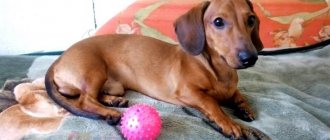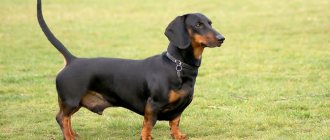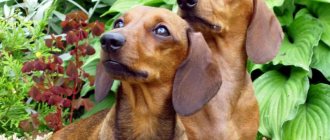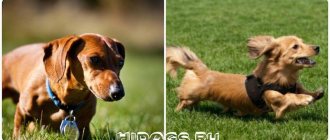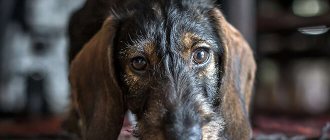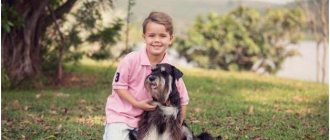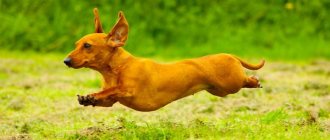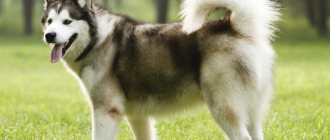Historical information about the origin
It is difficult to name the exact period of appearance of the breed. There are claims that engravings on the walls of pyramids in Ancient Egypt contain figures of dogs with short and oblong muzzles.
It is officially customary to associate the origin of the dachshund with the 16th century, Southern Germany.
The main ancestors were short-legged and strong hound dogs, which were usually given the name: hunting marriage.
They inherited to the dachshund the ability to pursue game, which is important for hunting, using a voice message system for the hunter, ingenuity, courage and developed intuition.
For hounds, short legs were a disadvantage, but for the dachshund, which was created for hunting animals hiding in holes, this became a great advantage.
The dachshund acquired its present characteristic features at the end of the 18th century. Its population increased significantly, dogs were exported outside of Germany, and division into indoor-decorative and hunting representatives began.
At the end of the 19th century, a club of breed supporters was formed in Germany, and standard indicators were approved.
The breed appeared in Russia in the mid-17th century. Most often, the dachshund was considered as a representative of a decorative breed.
She was quite popular among the creative intelligentsia. For example, Chekhov A.P. wrote about dachshunds that they are “extraordinarily intelligent” dogs.
In addition, Napoleon was very fond of short-legged, four-legged pets. He even left a will to bury them in his grave.
Briefly about the breed
The first mention of dogs that visually resemble dachshunds dates back to the times of Ancient Egypt. If you look at the engravings on the walls of ancient Egyptian pyramids, you will see images of dogs with sharp muzzles, which makes them look like dachshunds.
In Germany in the eighteenth century, dogs resembling dachshunds were called badgers or miners. It’s easy to guess that these are fast and smart dogs that help hunters. The dachshund was believed to be a descendant of the German Bracket, a short hound dog popular in Germany. However, German hunters considered that the Bracket had significant disproportions in the body and limbs, which was considered a disadvantage of the breed. Therefore, it was decided to breed a new hunting breed that would combine such characteristics as a long body and massive shortened legs, which would allow the dog to easily get into the holes of animals such as foxes and badgers.
By the end of the eighteenth century, the dachshund had become the most popular breed in Germany. Kennels began to be organized in the country where dogs of this breed were bred. At the same time, the dachshund as a breed spread beyond Germany throughout Europe.
General description and color
Despite their small size, dogs of this breed are distinguished not only by their mobility, but also by their strength, since they have a rather muscular body on short, strong legs.
The brisket proudly protrudes forward, the tummy seems to be drawn in, the tail is a continuation of the line of the back.
The head is slightly elongated, the eyebrows are graceful arches, giving the dog the appearance of a thinker with a slightly indifferent calm.
Powerful jaws with a scissor bite make it clear that this impression is only apparent.
Eyes with an oval cut, dark red or brown. The ears are medium in size, soft and mobile with rounded tips and hanging along the cheeks.
Conventionally, 4 types of coat color can be distinguished:
- monochromatic color: yellowish-red, just red, soft pale-yellowish pure or there are a few inclusions of black, even color of the same color is more valued;
- two-tone coat color: the main color is chocolate or black with tan spots of brown and red or straw color. The spots are located on the side of the muzzle, inside the ear, lower jaw, on top of the eyebrows, on the chest, limbs, and the lower section of the tail;
- marble look of the pattern, the main color is rich dark: gray, red, black with a characteristic chaotic arrangement of spots of light beige or light gray;
- color with a brindle pattern: the base is red or fawn with dark stripes.
Main varieties
The classification of dachshund breed types by coat is as follows:
- having smooth wool;
- with long hair;
- owners of hard wool.
Varieties according to sizes:
- standard: height from 20 to 27 centimeters, chest volume not less than 35 centimeters, weight up to 9 kilograms;
- dwarf: height from 14 to 21 centimeters with chest volume (for ages from 1.3 years) 30-35 centimeters, two times lighter than standard;
- rabbit: the weight of the smallest dachshunds is on average about 3.5 kg, height is only from 10 to 15 cm, chest circumference is 30 cm. The standards are relevant for an age of at least 1.5 years.
Life expectancy and health
The main problem of white dachshunds, just like other dachshunds, is problems with the spine. Limiting jumping minimizes injuries. A dangerous factor is obesity, which can worsen the situation. Crossing two white dachshunds is strictly not recommended. Puppies from such a couple are born weak with all sorts of abnormalities and require constant supervision. Such puppies have a special mark in their documents.
Dachshunds live on average 12-13 years, you can add a couple of years with good maintenance and care.
This breed has a number of genetically transmitted diseases:
- Osteoparosis.
- Cataract.
- Diabetes.
- Diseases of the genitourinary system.
Dachshunds, which nature has endowed with weak pigmentation, have lower immunity than their counterparts of other colors.
Smooth-haired
The smooth-haired dachshund originated from crossing, most likely, a French basset hound and a pinscher.
Representatives of species with smooth coats have short, close-fitting hair lengths.
Among the characteristic features are folds of leather covering the paws. This is the very first of all available types of dachshund breed.
She is very attached to her owner and is his brave protector.
The dog is stocky with an elongated body and does not look awkward or immobile. He likes to take long walks with his owner and is a good travel companion.
Dog owners say that they are difficult to train, but much easier to raise. No special care required.
It is enough to rub the coat with a special cloth once a day.
What causes the appearance of ulcers
For people dealing with skin diseases of dogs, ulcers are familiar. This term refers to inflamed lumps on the dog’s skin. Abscesses are detected by palpation or in an advanced state during visual examination.
Each owner inspects the dachshund independently. When looking at a pet, a person does not see spherical seals, bright red spots and all kinds of scratches. The listed elements become the first stage of development of ulcers. Veterinarians are asked to examine the dog's body and look for papules. These are peculiar swellings, in the center of which a rod can be felt.
Similar ulcers appear on the face. Less common on the abdomen and open areas of the skin. Papules are the result of excessive sebum secretion and dirt entering the pores, which together give rise to a purulent neoplasm.
Additionally, the owner notices nodular formations and peculiar balls under the skin that move easily when pressed. As a rule, they are localized in the groin, axillary folds and belly.
Unfortunately, the causes of ulcers are different. If we are talking about an old dog, the formations signal a weakened immune system and precarious health of the pet.
Longhair
The long-haired dachshund is the result of crossing a smooth dachshund and a spaniel.
Especially with such representatives of the breed in Russia, a decline in hunting qualities is clearly manifested; it becomes a fashionable long-haired decorative dog.
According to standards, it differs from smooth-haired only in the length of the coat.
The length of the coat becomes stable at about the age of two years, after several molts.
Then her fur coat becomes long with a silky sheen, it fits tightly on the body, and has a natural glossy shine.
Representatives with long hair have long hair that fits tightly with undercoat and fringes near the ears and on the tail.
Answer
Each breed has characteristic diseases. For example, veterinarians consider dachshunds to be problematic.
The fact is that dachshunds are specific in their handling. Herniated discs are common in dogs and are caused by stress on the discs. Few people know that there is a common disease that affects dogs of this breed. We are talking about alopecia. Experienced dog breeders know that the disease is associated with partial, sometimes complete loss of hair. In other words, the dog remains bald, which horrifies the owners. People concerned about the health of their pets are interested in this disease.
Alopecia is associated with weakening of pigmentation. Dachshunds with a heterogeneous color, for example, gray and tan, are susceptible to the disease. Do not think that pets of other colors do not experience baldness. The development of the disease is associated with genes. If a domestic animal is homozygous, possessing a set of identical genes that were passed down from the father and mother, the dog will be susceptible to alopecia. The action of the disease is aimed at suppressing the black pigment in the color. However, exceptions rarely occur, and the owner of a dachshund is faced with the fact that his pet is going bald.
Baldness begins before one year of age. At 6 months, the dog becomes covered with bald spots, which are often confused with the manifestation of ringworm. But bald areas do not become covered with itchy spots. The fur thins out in the back area, the process is noticeable on the sides. The dark areas of the color remain intact until the age of three. There are dachshunds that are hairless on the sides and back, and whose heads and other parts of the body are covered with hair. Unfortunately, by the age of six, the process is completed, and a “naked” dog appears before the owner.
Doctors are rushing to reassure people who are thinking about purchasing a dachshund. As a rule, dachshunds with this color are rare. This means that a minority of dogs suffer from alopecia.
Wirehaired
The youngest of all the wire-haired dachshunds, its origins lie in the crossbreeding of a smooth dachshund with a terrier.
It is not known exactly which terriers took part in the formation.
The wire-haired dachshund differs from its close relatives in its coat and, accordingly, in its appearance, which distinguishes it from its relatives.
The appearance is more like a kind of house-elf. This appearance of an old man is given by the long hair on his face: a mustache, thick eyebrows, and a beard. It is very interesting and funny to look at such dachshunds.
A coat of coarse hair perfectly performs a protective function in bad weather, does not allow water to penetrate the skin, which ensures comfort for the dog even in cold rain.
Standard
Ordinary dachshunds are conventionally divided into the “small standard” and “large” groups. Small ones typically weigh 6-8 kilograms, large ones - from 8 to 12.
Rare, but likely to be found up to 15 kg. Such dachshunds are certainly not suitable for hunting burrowing animals, and in an apartment they will probably crowd out their owners.
According to the standard, weight should not exceed 9 kilograms.
The dachshund is not picky, does not require large maintenance costs, and does not need any special care.
The occupation of the owners of such dogs is completely far from hunting, which is why the breeding of dwarf and rabbit species began.
Types and Types of Dachshund Dogs
Today there are the following types of dachshunds: long-haired, short-haired, wire-haired, as well as standard, dwarf and very small (rabbit, or toy dachshunds).
The modern dachshund is perhaps the most “rich” breed of all. There are three types of dogs based on their coat: smooth-haired, long-haired and wire-haired. Within each of these varieties, there are three types of dachshunds based on size: standard, dwarf and rabbit.
In Russia, until 1981, there was no provision for dividing the breed by size - dog breeders of the former USSR until the early 1990s. Only standard dachshunds were bred. The current standard (since 1981) provides for classification by size. So below you can see photos of dachshund species:
large (normal) males and females - 22-27 and 20-25 cm;
medium (dwarf) - 21-16 and 19-14 cm, respectively;
small (rabbit) - 15-12 and 13-10 cm.
As follows from the description of Dachshund dogs, regardless of coat, the main difference between animals is their size.
Dwarf
The main parameter for determining whether a one-year-old dachshund is classified as a particular species is the volume of the brisket.
For a dwarf it varies from 30 to 35 centimeters; if the figure is higher, then it is a regular dachshund.
Of course, the character of a dog is very dependent on upbringing, but it can be noted that small sizes (dwarf, rabbit) are reflected in the dog in such a way that they are more cunning, angrier, more arrogant and aggressive than ordinary dachshunds, and at the same time they need the most sensitive treatment.
Nature and basic rules of care
White dachshunds are sociable dogs, they are friendly, and if the first acquaintance went smoothly, then friendship is guaranteed.
Animals treat children well, but they will not babysit or tolerate child provocations. To avoid problems, it is enough to follow simple rules and not cause pain.
The Dachshund likes to make independent decisions. Many breeders call this stubbornness. If you are patient during training and education, you will be provided with a model of obedience.
The Dachshund will react instantly to rudeness and injustice.
Loneliness is the worst punishment for a dachshund. The surrounding objects will be the first to be affected.
The dachshund is a smart and quick-witted animal, you can find an approach to dachshunds with the help of food, they love to eat. The main thing is not to overfeed!
They get along well in an apartment and in a house; care for dachshunds is minimal. The only caveat is that you should be prepared for the fact that the little dachshund will want to taste everything.
Caring for a white dachshund is just as easy as caring for a regular dachshund:
- It is customary to bathe a dachshund once every three months; with white fur, this procedure may be required more often for its aesthetic appearance.
- Cut your nails every two weeks.
- Wipe eyes with a cotton pad or soft cloth with warm water.
- Clean your teeth regularly to remove plaque, otherwise tartar will form.
- Long ears collect dirt and require attention: inspection after each walk, and cleaning with a swab with hydrogen peroxide once a month.
- Groom the coat with a mitten brush.
- Get toys, balls and bones so that your interior items don’t suffer.
Rabbit
Of the variety of dachshunds, the smallest specimen is the rabbit dachshund. She was bred to hunt rabbits. A variety appeared towards the end of the 19th century.
The appearance and behavior are similar to the previous type of breed. During the breeding process, they crossed a toy terrier and baby pinschers to produce the smallest dachshund.
Initially, they were attracted only to hunting rabbits, hares and other similar small animals, then they became less and less common as working animals, acquiring the status of decorative dogs.
Although it is never too late, if you wish, you can develop the qualities of a hunter today.
Such parameters allow you to be professionals in the field of burrow hunting for rabbits, since in the process you need to quickly move through narrow burrows.
Origin story
The history of the origin of dachshunds goes back a long way.
Their images are found in drawings of Ancient Egypt; Germany is considered the birthplace of the breed during the heyday of the Roman Empire. The name dachshund comes from the word "badger", which in German sounds like "daxa". The breed was bred for the purpose of hunting, the main factor being working qualities. At the same time, colors were given secondary importance; among others, white dachshunds were also found. After the breed standard was approved, acceptable colors were also designated; white color was not included in the standard.
Thanks to its exterior, the dachshund is an indispensable assistant in burrow hunting. Short limbs made it possible to freely penetrate burrows and successfully fight pests back in the 16th century.
In the 17th century, dachshunds began to be purposefully bred in nurseries, and were divided into workers and ornamentals.
In 1870, a standard for dachshunds was adopted, where the breed was recognized as a hunting one.
Photo gallery
Considering the variety of varieties of this breed, there is no doubt that anyone can find a faithful friend to their liking. We invite you to verify this by viewing our photo selection.

